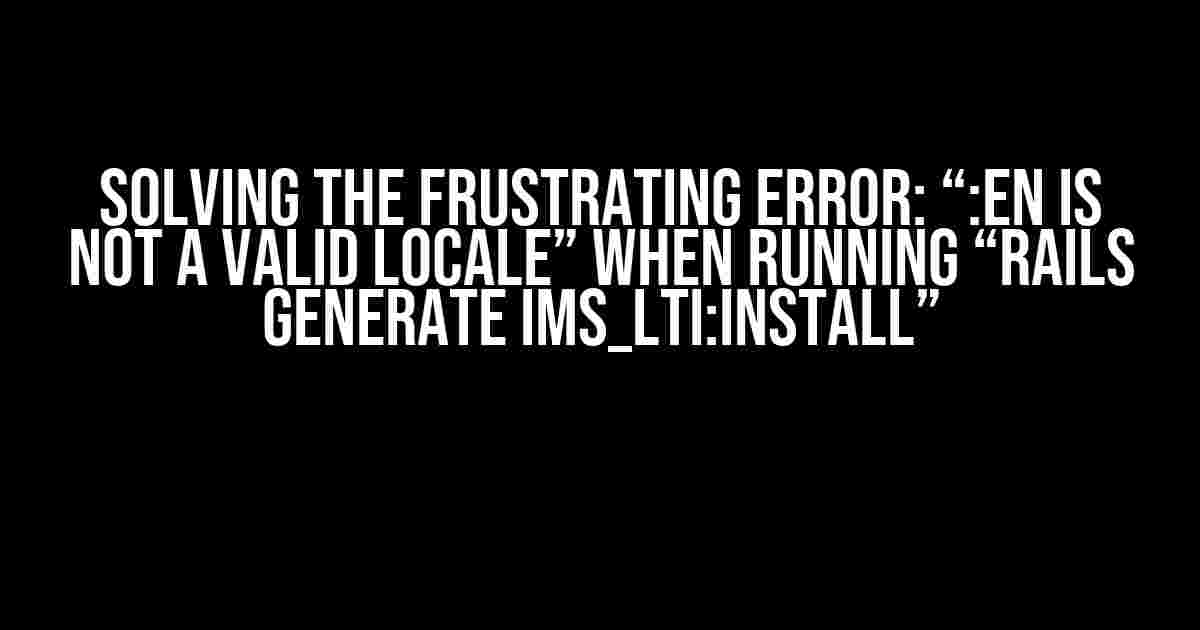Are you tired of encountering the annoying error “:en is not a valid locale” when trying to install IMS LTI with Rails? You’re not alone! This error can be frustrating, especially when you’re excited to start building your Learning Management System (LMS) integration. Fear not, dear developer, for we’re about to tackle this issue head-on and get you back on track.
What is IMS LTI, and Why Do I Need It?
IMS LTI (Learning Tools Interoperability) is an open standard that enables seamless integration between Learning Management Systems (LMS) and third-party tools. It allows teachers to access and use external learning tools from within their LMS, creating a more cohesive and efficient learning experience.
If you’re building an LMS or a learning tool, integrating IMS LTI is a must. It enables you to:
- Provide a single sign-on experience for users
- Share data and grades between systems
- Enhance the overall learning experience
The Error: “:en is not a valid locale” – What Does it Mean?
The error “:en is not a valid locale” occurs when Rails can’t find a valid locale (language and region) configuration in your application. IMS LTI relies on this configuration to function properly. By default, Rails uses the “:en” locale, which represents English. However, in this case, it’s not recognized as a valid locale, causing the installation to fail.
Step-by-Step Solution to the Error
Follow these steps to resolve the error and successfully install IMS LTI:
-
Check Your Rails Version
Make sure you’re running Rails 5.2 or higher. If you’re on an earlier version, upgrade to the latest version using the following command:
gem update rails -
Verify Your Locale Configuration
In your Rails application, navigate to the
config/localesdirectory. You should find a file nameden.yml. If it’s not there, create a new file with the following content:default_locale: en en: hello: "Hello"This sets the default locale to English (en).
-
Update Your Application Configuration
In your
config/application.rbfile, add the following line:I18n.default_locale = 'en'This sets the default locale for your application to English.
-
Run the IMS LTI Installation Command Again
Now, run the installation command again:
rails generate ims_lti:installIf everything is set up correctly, you should see the installation succeed.
Troubleshooting Tips
If you’re still encountering issues, try the following:
-
Check your locale files for typos or incorrect formatting. A single mistake can cause the entire installation to fail.
-
Verify that your Rails version is compatible with the IMS LTI gem. You can check the gem’s version compatibility in the
ims_lti.gemspecfile. -
If you’re using a custom locale, ensure it’s correctly configured and matches the locale you’re trying to install IMS LTI with.
Conclusion
Solving the “:en is not a valid locale” error when running “rails generate ims_lti:install” might seem daunting, but by following these steps, you’ll be up and running in no time. Remember to double-check your locale configuration, update your application settings, and verify your Rails version. With IMS LTI installed, you’ll be able to create a seamless and efficient learning experience for your users.
| Error Solution | Steps |
|---|---|
| “:en is not a valid locale” |
|
Happy coding, and may your LMS integration be error-free!
Frequently Asked Question
Rails enthusiasts, gather ’round! We’ve got some burning questions about that pesky “en is not a valid locale” error when running “rails generate ims_lti:install”. Let’s dive in and get those answers!
What does the “en is not a valid locale” error mean?
This error pops up when Rails can’t find a matching locale for “en” in your application’s configuration. It’s like Rails is saying, “Hey, I don’t recognize this language code!”
Why does this error happen when running “rails generate ims_lti:install”?
The IMS LTI tool is trying to set up the locales for your app, but it’s getting stuck on the “en” locale. This might be due to a missing or misconfigured locale file in your Rails app.
How do I fix the “en is not a valid locale” error?
Easy peasy! Just create a new file named `en.yml` in the `config/locales` directory of your Rails app. Add some basic locale settings, like `en: english`, and you’re good to go! Rails should now recognize “en” as a valid locale.
What if I have other locale files, like fr.yml or es.yml?
No worries! If you already have other locale files, just make sure to add the `en.yml` file alongside them. Rails will happily recognize all your locales, including “en”.
Will this fix work for all versions of Rails?
This fix should work for most Rails versions, but keep in mind that locale handling has changed slightly across different versions. If you’re running an older version of Rails, you might need to check the specific locale setup recommendations for your version.

